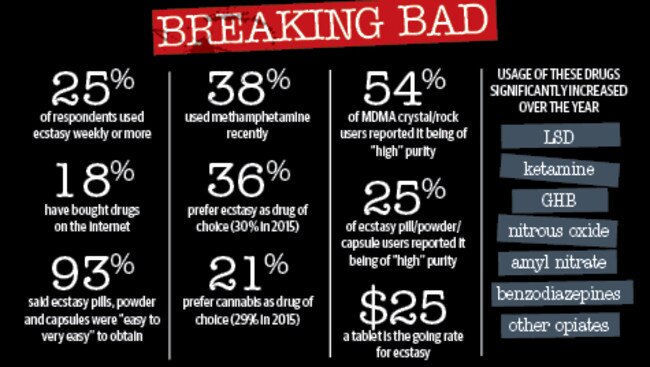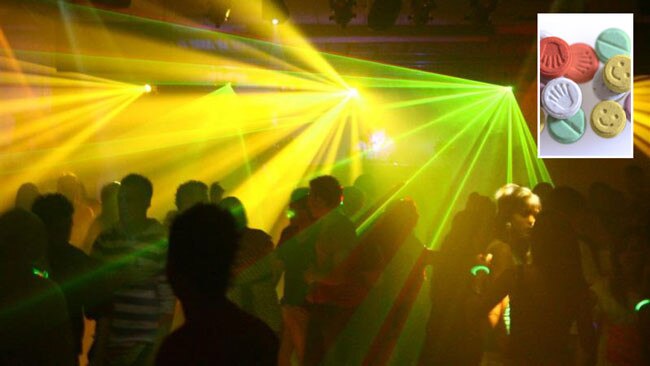Police warn of potent new deadly drugs
UPDATE: A 30-year-old man has been charged following a string of revellers being taken to hospital after taking dodgy drugs over the weekend.
Law & Order
Don't miss out on the headlines from Law & Order. Followed categories will be added to My News.
ABOUT 20 people have been taken to hospital after taking dodgy drugs over the weekend.
The incidents are believed to be linked to a bad batch of MDMA which was doing the rounds at Chapel St nightclubs.
Victoria Police said a 30-year-old man was arrested about 4am today after nightclub staff called police.
The man has since been charged with traffic and possession of MDMA and possession proceeds of crime.
The overdoses and arrest come on the back of warnings by authorities about a new wave of powerful drugs that are on the streets.
Victorian detective Sen-Sgt David Newman said people should be aware of the risk and think twice about taking these drugs.
“There is always a risk whenever someone chooses to take drugs on a night out but clearly this risk is particularly heightened at the moment with what we’ve seen this weekend,” he said.
“Drugs such as MDMA are dangerous and manufactured by criminals with absolutely no regard for the safety of the people who take them.
“It’s important that people realise they’re putting themselves in danger of not just hospitalisation, but permanent disability or even death by consuming these drugs.
“We want people to come and have a fun and safe night out, and the last thing police want to be doing is knocking on your family’s door because a tragedy has happened.”
The supercharged psychostimulants are laced with potentially lethal contaminants, authorities warn.
Police warn that the latest illicit substances, which forensic testing has found to be up to five times stronger, have “high toxicity” and are made from compounds “not known to us”.
In recent cases users have experienced paranoia, hallucinations and heart-rate elevations high enough to kill.
The latest fatality was 26-year-old Jake Monahan, of Nimbin, who died when his body and brain overheated and he suffered a cardiac arrest at an unofficial dance festival at Mount Lindesay in Queensland on New Year’s Day.

Research from the National Drug and Alcohol Research Centre reveals an increasing trend in the consumption of ecstasy — up 6 per cent on 2015 — and what users consider to be its more potent form, MDMA crystal/rock.
In its Ecstasy and Related Drugs Reporting System (EDRS) 2016 data, 93 per cent of the 1000 study participants say it remains “easy to very easy” to obtain.
It comes as experts warn poly drug use is rising, with many of those interviewed combining a potentially lethal cocktail of up to 10 different substances.
The Queensland co-ordinator for EDRS, Caroline Salom, said a new series of products had emerged that testing identified to be up to five times more potent.
Dr Salom, from the Institute for Social Science Research at the University of Queensland, said this was believed to be the result of overseas cartels looking to boost their market share.
She warned that the latest offerings peddled as ecstasy could now include dangerous “contaminants” ranging from amphetamines to compounds from the NBOMe group.
These were known to cause serious health problems that could be fatal.

“Ecstasy is back in fashion,” Dr Salom said.
“This is due to the higher potency … there are higher amounts of MDMA (ecstasy).
“However, we are aware of a number of other substances found in the pills, capsules and crystalline.
“Pills tested by police have shown up to five times the previous average of potency — that’s a red flag.
“The biggest issue is that people don’t seem to see their use as a problem, so they don’t seek help.”
The report found that the price of ecstasy pills had remained unchanged, at between $20-$25.
Queensland Drug and Serious Crime Group detective Superintendent Jon Wacker said the new drugs “coming on the scene every week” were getting stronger, with some so powerful they were even catching out seasoned users.
Supt Wacker said police research and surveys showed the drugs had “high toxicity” and were made from compounds “not known to us”.
“If you want to indulge, you are playing Russian roulette. Tragically, in recent months we have seen that they don’t discriminate … whether you are a first-time user or a seasoned user, they can kill you,” he said.
Supt Wacker said the main weapon in combating the issue was education and that public help was also critical to “tell us who these pushers are”.
“We are also seeing greater collaboration within law-enforcement agencies around Australia and internationally,” he said.
“We have to work together as the organised crime gangs pushing these substances don’t have borders.” The illicit products can arrive by human courier, through the mail, or via shipping.
Victorian football player Riki Stephens died after taking a lethal drug cocktail that put 16 people in hospital on the Gold Coast last October.
Mr Stephens was on an end-of-season holiday in Queensland with his Heathcote Saints Football Club teammates when he, along with about nine other players, ingested a drug cocktail found to contain the compound NBOMe.
This psychoactive ingredient is believed to have led to the death of Australian Rye Hunt in Brazil last May.
SECRETIVE MUSIC FESTIVALS A STAGE OF HIGH RISK
REMOTE dance parties known as “bush doofs” are putting lives of drug users at even greater risk, police say.
Unofficial music festivals promoted through social media are being held on private properties in rural areas.
Logan District detective Acting Inspector Peter Waugh said bush doofs were secretive “for a reason”, away from the gaze of authorities.
He said those taking drugs at a fatal bush doof at Mount Lindesay near the Queensland-NSW border on New Year’s Day had put themselves in grave danger due to the distance from medical help.
The event claimed the life of 26-year-old Nimbin man Jake Monahan and left two other revellers in a critical condition.
They were left stricken by a drug they believed to be ecstasy, but which contained properties that produced hallucinations, incoherent speech and erratic behaviour, including clawing at the ground.
Acting Insp Waugh said that while the exact chemical make-up of the substance was yet to be determined, it had caused a grossly elevated heart rate, overheating and convulsions.
“It appears that it fried their brain,” he said.
In Mr Monahan’s case, the reaction ultimately led to cardiac arrest.
Acting Insp Waugh said similar events had been held over the border in NSW and were commonly advertised on social media. He said they attracted hundreds of people and had a lack of proper security and medical support.
“Because of their isolated locations, these events have the added danger of being far from help when things go horribly wrong.”
